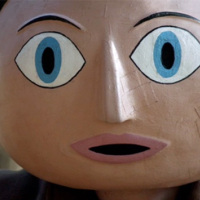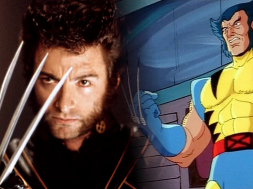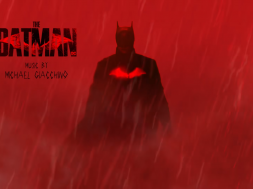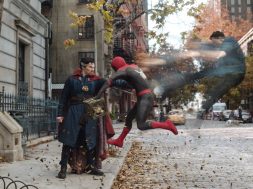
One of the advantages of writing for the Arcade is that you are given something of a free reign over what you write. The down side is that the day job gets in the way. Still, in the case of Frank I cannot help think this has been advantageous: having seen the film just over a week ago it has been comfortably fermenting at the back of my head ever since. So here, belated, is Frank. Then again, finding the time to jot down my thoughts on one film or what-not is almost invariably only half the battle, maybe less so here. “How to describe Frank?”. You’ve probably heard Jon Burroughs (Domhnall Gleeson’s character) ask that question in the trailer. While Jon is not a character with whom it is necessarily flattering to identify, the question is pertinent. How to describe Frank? How to describe Frank? It is (almost) not a rhetorical question. The film leaves you unsure as to what you’ve just witnessed.
 One cannot help mentioning the autobiographical/ historical notes, but doing so is an impotent move. Still, my understanding being as so sketchy as it is I won’t linger on it too long. Ignorance then, if not blissful, proves strangely apposite. The screenplay began life as an article by Jon Ronson on the late comedian-musician Christopher Mark Sievey. During the 80s Sievey developed a comic-persona Frank Sidebottom. He would appear on stage wearing a suit and a giant paper mache head. Ronson witnessed the character at close range having appeared on stage with the Sievey in Frank Sidebottom and the Oh Blimey Big Band. The plot also has its roots in music past. The film begins with Jon Borrows (a fictionalised Ronson) working a dead-end job, living with his parents, and all the while trying to make it as a musician. Out one day he notices a man attempting to drown himself while a group look on in silence, faces blank. It transpires that these impenetrable cohorts are in a band and the man charging the waves is their keyboard player. When the half-drowned man is taken in by paramedics, Jon offers himself as a replacement. Following a dreadful gig where he meets frontman Frank for the first time he is offered the chance to rehearse and record the next album for the band Soronprfbs in Ireland. He accepts not knowing he will stay a year, a conceit that takes inspiration from the stories surrounding the recording of Trout Mask Replica by Captain Beefheart.
One cannot help mentioning the autobiographical/ historical notes, but doing so is an impotent move. Still, my understanding being as so sketchy as it is I won’t linger on it too long. Ignorance then, if not blissful, proves strangely apposite. The screenplay began life as an article by Jon Ronson on the late comedian-musician Christopher Mark Sievey. During the 80s Sievey developed a comic-persona Frank Sidebottom. He would appear on stage wearing a suit and a giant paper mache head. Ronson witnessed the character at close range having appeared on stage with the Sievey in Frank Sidebottom and the Oh Blimey Big Band. The plot also has its roots in music past. The film begins with Jon Borrows (a fictionalised Ronson) working a dead-end job, living with his parents, and all the while trying to make it as a musician. Out one day he notices a man attempting to drown himself while a group look on in silence, faces blank. It transpires that these impenetrable cohorts are in a band and the man charging the waves is their keyboard player. When the half-drowned man is taken in by paramedics, Jon offers himself as a replacement. Following a dreadful gig where he meets frontman Frank for the first time he is offered the chance to rehearse and record the next album for the band Soronprfbs in Ireland. He accepts not knowing he will stay a year, a conceit that takes inspiration from the stories surrounding the recording of Trout Mask Replica by Captain Beefheart.
So in summary, just to avoid any confusion, the film is not a biopic. The first names have been borrowed for Frank and Jon, along with the noggin for the former. Music history and Ronson’s past are the jumping-off point and the film leaves them in its wake. Therefore giving them either undue focus is as easy as it is misleading: the film’s genesis is the one of its few certainties. You might (perhaps some of you already have) walk into the cinema expecting a film like Garden State (2004), but Frank in tone is far more tragi-comic.
If any attempt is made at reviewing the film it must start with the obvious (the nose-wrinklingly obvious). The head, like all masks, is a barrier that shuts Frank off. Indeed, Frank is able to undergo isolation for long stretches (much impressing Jon Burrows). Yet as the film progresses it seems hard not to identify with him in a way that recalls pre-talkie cinema; in the absence of one stimulus, others are paid more attention to. The lighter half of the magic act Penn and Teller has said that shutting-up made the shows far more intimate. At the outset the face appears askance and surprised, even stand-offish. The face anticipates the audience’s reaction to it. However, as we come to know our mysterious muso the expression seems to change and with it so do our. While looking through the presses I was pleased to find that Peter Bradshaw had also noticed how the face recalls the observations of Kuleshov (and slightly galled he piped me to the post). He writes:
After a while, his strange, blank papier-mache stare actually appears to change expression, subtly, with the dialogue, a comic optical illusion that Frank himself whimsically enforces by telling everyone what his expression is underneath – “non-threatening grin” etc. It is a sort of Kuleshov effect – in the 1920s, Russian film-maker Lev Kuleshov showed audiences the same actor’s unchanging face in different contexts and persuaded them to believe the actor was expressing grief, rage, ecstasy etc.” (Source The Guardian)
Before long the face between the face beneath the face becomes superfluous. Watching Frank I felt I was able to intuit his reactions as my own, knowing his reactions and reacting myself in much the same way. By contrast, Gleeson’s face, innocuous at the outset, that grows stranger, more false.
But, even as we understand Frank, what of Frank?
The film clearly deals in the relationship between genius, fame and mental health, but does not deal in the clichés and assumptions that have associated with any of those areas. Frank like Jon is anxious for the approval of others, as is made evident from the consistent refrain to social media, but is ultimately unwilling to make compromises for that validation. Frank is clearly a genius but the extent to which the mask is a catalyst to creativity is dubious. The mask is symptomatic of psychological problems but how conducive the mask, the isolation it encourages and the problems it symptomatizes are to output is dubious. The cliche is that artist’s have to be sufficiently removed from their subject to address them. The head provides a physical and emotional barrier to the outer world and implies that the one underneath operates in a way that is removed from that outer world. Frank as a film is aware of the history but deviates from the all to familiar formula, dances to its own tune.
Whatever may be said of the film’s plot or character it is also about music and while I wait for the film’s release I am also awaiting the soundtrack too. For a taste:
The heartfelt melody juxtaposes with the stream-of-consciousness description and a shrill electronic backbeat. The effect encapsulates the bittersweet tone of the whole piece. It is the latter part of that term (bittersweet) that now needs addressing. The film is a touching one and is not, as I fear I’ve mislead you, relentlessly sombre. Jon Ronson and Peter Straughan have developed a script that has no small number of laughs. Under the director Lenny Abrahamson the film switches registers with seamless charm.
Frank is not for everyone. Its reference points and tone make it stand apart from much of the fare. It might, therefore, be considered niche. However, the humour penetrates through the musical esotericism so that the film reaches you whether you are steeped in such recondite refinances or not. At the risk of sounding a little precious, anyone who would allow themselves to be turned-off by that esotericism would be committing an act of privation. It is a film that stays with you. Even as I write I can feel the aforementioned ferment fizz afresh.
It would be foolhardy to try and capture much more of Frank in the screen inches of an online review. I submit. At the point where I am meant to come up with some pithy remark signalling the end of my tirade, I submit. Still I can’t just give up (I have standards and my editor certainly does ). So I’ll simply say this:
CHINCILLA!
[easyreview cat1title=”The Arcade Verdict” cat1detail=”” cat1rating=”8″]











